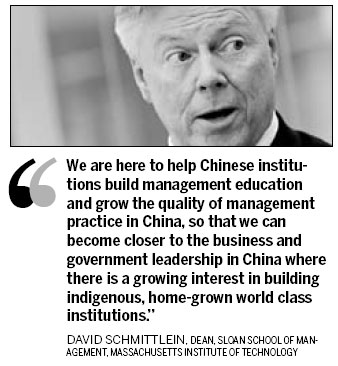Business
Business schools looking East
Updated: 2011-01-24 08:02
By Li Xiang (China Daily)
|
Students cross Massachusetts Avenue in front of the main administration building at the Massachusetts Institute of Technology (MIT) campus in Cambridge, Massachusetts. MIT Sloan School of Management is one of the first Western business schools to establish partnerships with management institutions in emerging countries. Neal Hamberg / Bloomberg |

BEIJING - While the world economy is still recovering at a sluggish pace, Western business schools are expanding rapidly and many of them are pursuing growth in emerging countries vigorously as a way to balance their budgets.
Rather than relying on the old business model, many Western business schools are seeking international growth by setting up educational facilities abroad or co-branding with local management education institutions.
"All of the very top schools in North America, including MIT Sloan, actually lose money on every program we run, especially on the programs that provide a degree," David Schmittlein, dean of the Sloan School of Management, Massachusetts Institute of Technology (MIT), told China Daily.
While being keen on building global networks, most Western business schools are choosing to focus on emerging regions such as Asia and Latin America to boost their presence outside their home country and to serve the school's mission.
"The mission is to lead business and government leaders around the world to value the school and choose to support that school," Schmittlein said.
"That's the only way that my school actually is able to balance the budget," he said, noting that about 50 percent of MIT Sloan's budget comes from tuition and the other 50 percent comes from corporations, alumni, and friends of the school around the world.
MIT Sloan is one of the first Western business schools to establish partnerships with management institutions in emerging countries. Its partnership with Chinese institutions started in 1996 when MIT Sloan launched the MIT-China Management Education Project to strengthen graduate management education programs at selected Chinese universities.
Tsinghua University in Beijing was the initial partner of the project and Fudan University in Shanghai and Lingnan College of Sun Yat-sen University in Guangzhou later joined in 1999.
"We are here to help Chinese institutions build management education and grow the quality of management practice in China, so that we can become closer to the business and government leadership in China where there is a growing interest in building indigenous, home-grown world class institutions," said Schmittlein.
The project brings a Chinese faculty to MIT Sloan for training in teaching and course development. It also sends MIT Sloan faculty members to the Chinese campuses to give lectures and teach short courses.
"The purpose is to develop and train a management faculty that can really create knowledge about China, for China, and for the world," Schmittlein said.
Beyond China, MIT Sloan also established teaching facilities in Russia, Singapore, the Republic of Korea and Portugal.
The school is not alone in having a growing presence in China. Harvard Business School, for the first time in its 101-year history, opened its first teaching facility outside the US, in Shanghai. European business schools such as the Judge School of Cambridge University also have similar plans in China.
Despite the breakout of the global financial crisis and the slow recovery pace of Western economies, Schmittlein pointed out that the growth of first-class business schools tends to be counter-cyclical.
"In a period of economic stress, people are not so confident that there will be a job waiting for them if they leave their current position, so it is really the top schools that continued to be able to offer productive job opportunities," he said.
MIT Sloan's applications have increased by 57 percent during the last three years, which is the highest level of increase in applications among any of the leading business schools in the US, according to Schmittlein.
China Daily
Specials

President Hu visits the US
President Hu Jintao is on a state visit to the US from Jan 18 to 21.

Ancient life
The discovery of the fossile of a female pterosaur nicknamed as Mrs T and her un-laid egg are shedding new light on ancient mysteries.

Economic Figures
China's GDP growth jumped 10.3 percent year-on-year in 2010, boosted by a faster-than-expected 9.8 percent expansion in the fourth quarter.
